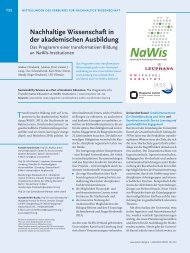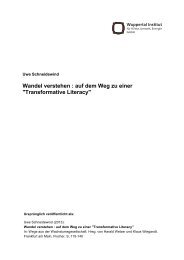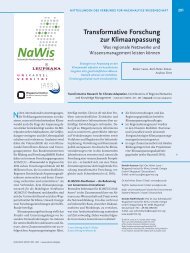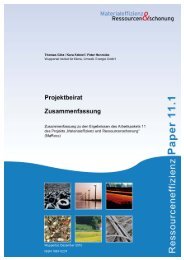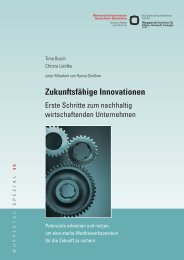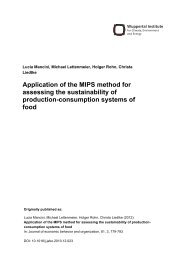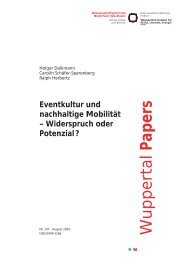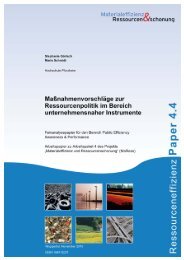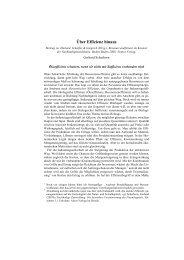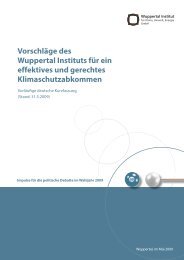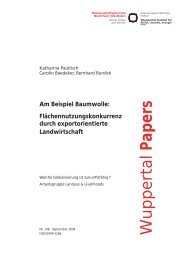Resource Efficiency Atlas - Publication Server of the Wuppertal ...
Resource Efficiency Atlas - Publication Server of the Wuppertal ...
Resource Efficiency Atlas - Publication Server of the Wuppertal ...
Create successful ePaper yourself
Turn your PDF publications into a flip-book with our unique Google optimized e-Paper software.
66<br />
Examples for resource efficiency | Strategies | Redesign and Re-use<br />
Strategies<br />
Redesign and<br />
Re-use<br />
Ressourceneffizienzatlas<br />
<strong>Resource</strong> <strong>Efficiency</strong> <strong>Atlas</strong><br />
Product-Service-System<br />
(use-phase)<br />
New production and<br />
consumption patterns<br />
Inclusion <strong>of</strong> RE into<br />
Standards<br />
A Swiss initiative shows how building materials can be handled in<br />
a closed loop<br />
Gravel for future generations<br />
The construction industry uses large quantities <strong>of</strong> materials. Cities <strong>of</strong>fer an enormous stock <strong>of</strong><br />
unused resources and many elements <strong>of</strong> construction waste, which can be recycled. The most<br />
prominent problem: <strong>the</strong> image <strong>of</strong> waste.<br />
Public Building <strong>of</strong> recycling-concrete<br />
(Source: AWEL Amt für Abfall, Wasser, Energie und Luft)<br />
About 50 million tons <strong>of</strong> mineral building materials are<br />
used in Switzerland each year. Thus, <strong>the</strong> construction industry<br />
is one <strong>of</strong> <strong>the</strong> industries with <strong>the</strong> highest material<br />
requirements. At <strong>the</strong> same time, large quantities <strong>of</strong> construction<br />
waste materials are accumulated each year due<br />
to redevelopment and demolition <strong>of</strong> existing buildings.<br />
These materials, however, can be recycled and used in cement<br />
production, for example. A study by <strong>the</strong> “Office for<br />
Waste, Water, Energy and Air“ (AWEL) <strong>of</strong> <strong>the</strong> canton Zurich<br />
from 2003 concludes that <strong>the</strong>re is no quality loss if <strong>the</strong>se<br />
materials are recycled. At present, concrete from recycled<br />
material still has different characteristics than <strong>the</strong> primary<br />
alternative. However, if <strong>the</strong>se characteristics are taken<br />
into account in <strong>the</strong> early stages <strong>of</strong> building planning process,<br />
recycled concretes can be used even for structurally<br />
challenging places. This certainly requires a new way <strong>of</strong><br />
thinking in <strong>the</strong> construction industry. Therefore, <strong>the</strong> AWEL<br />
initiated <strong>the</strong> Swiss information alliance “gravel for future<br />
generations“. This initiative aims to convey knowledge <strong>of</strong><br />
using construction waste and to facilitate information exchange<br />
between science and practice.<br />
<strong>Resource</strong> <strong>Efficiency</strong><br />
First <strong>of</strong> all, reusing construction waste reduces primary<br />
gravel resources and <strong>the</strong> demand <strong>of</strong> land for gravel exploitation.<br />
Moreover, <strong>the</strong> disposal <strong>of</strong> demolition material<br />
becomes redundant if recycled material is used. The use<br />
<strong>of</strong> construction waste compared to primary raw materials<br />
has only a minor influence on <strong>the</strong> production process <strong>of</strong><br />
concrete and <strong>the</strong> cement needed for it. In order to determine<br />
<strong>the</strong> environmental impact <strong>of</strong> <strong>the</strong> combustion <strong>of</strong> fossil<br />
raw materials during <strong>the</strong> process, <strong>the</strong> content and type <strong>of</strong><br />
cement as well as <strong>the</strong> transportation distance are crucial.<br />
This is a result <strong>of</strong> a lifecycle assessment done by <strong>the</strong> Swiss



